fuel pressure Acura TSX 2012 Owner's Manual
[x] Cancel search | Manufacturer: ACURA, Model Year: 2012, Model line: TSX, Model: Acura TSX 2012Pages: 324, PDF Size: 9.45 MB
Page 9 of 324
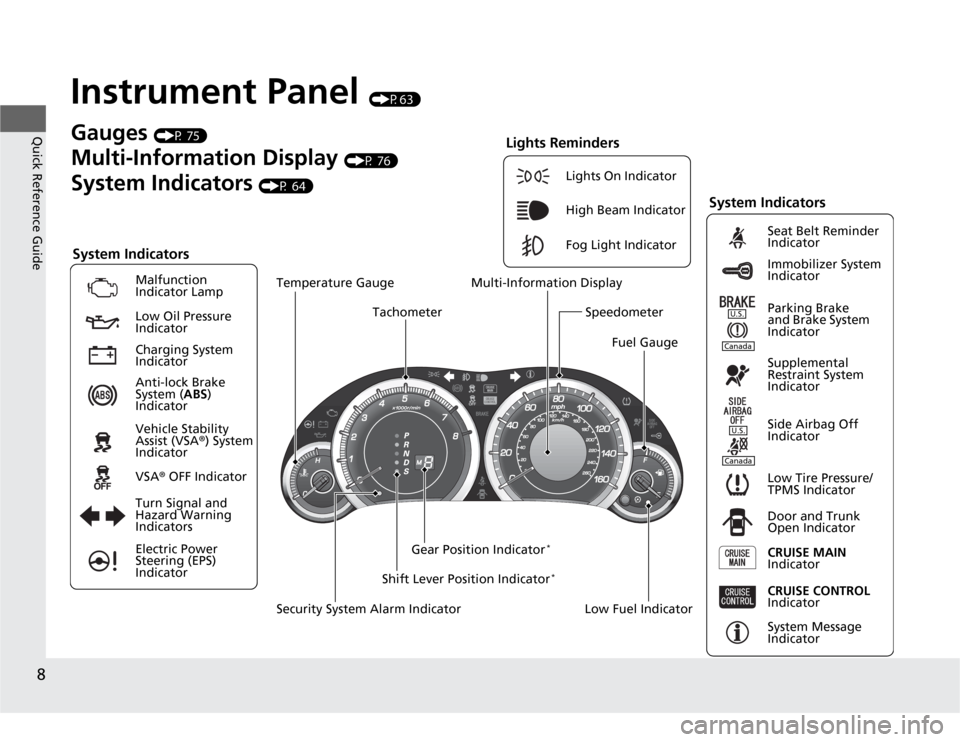
8Quick Reference Guide
Instrument Panel
(P63)
System Indicators
Malfunction
Indicator Lamp
Low Oil Pressure
Indicator
Anti-lock Brake
System (ABS)
Indicator
Vehicle Stability
Assist (VSA®) System
Indicator
VSA® OFF Indicator
Low Tire Pressure/
TPMS Indicator
Electric Power
Steering (EPS)
IndicatorLights On Indicator
High Beam Indicator
Fog Light Indicator
Immobilizer System
Indicator Seat Belt Reminder
Indicator
System Indicators
System Message
Indicator Parking Brake
and Brake System
Indicator
Supplemental
Restraint System
Indicator
Side Airbag Off
Indicator
Door and Trunk
Open Indicator
CRUISE MAIN
Indicator Tachometer
Low Fuel Indicator Security System Alarm IndicatorShift Lever Position Indicator
*
Gauges
(P 75)
Multi-Information Display
(P 76)
System Indicators
(P 64)
Turn Signal and
Hazard Warning
Indicators
Gear Position Indicator
*
Charging System
Indicator
CRUISE CONTROL
Indicator
Lights Reminders
Multi-Information Display
Speedometer
Fuel Gauge Temperature Gauge
U.S.CanadaU.S.Canada
Page 15 of 324
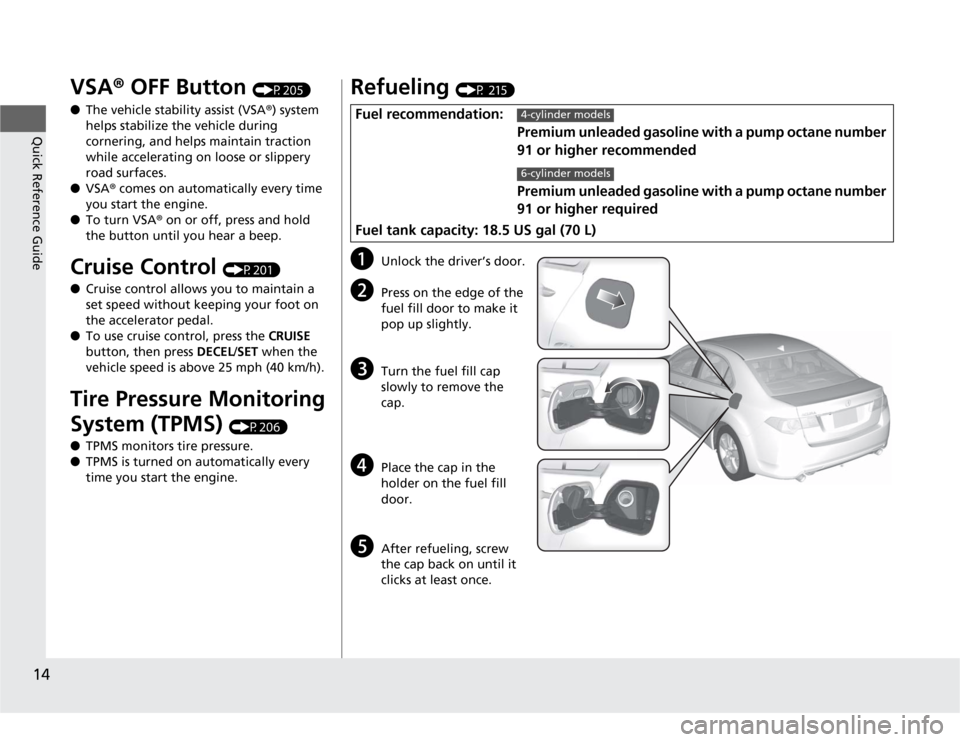
14Quick Reference Guide
VSA® OFF Button
(P205)
●The vehicle stability assist (VSA®) system
helps stabilize the vehicle during
cornering, and helps maintain traction
while accelerating on loose or slippery
road surfaces.
●VSA® comes on automatically every time
you start the engine.
●To turn VSA® on or off, press and hold
the button until you hear a beep.
Cruise Control
(P201)
●Cruise control allows you to maintain a
set speed without keeping your foot on
the accelerator pedal.
●To use cruise control, press the CRUISE
button, then press DECEL/SET when the
vehicle speed is above 25 mph (40 km/h).
Tire Pressure Monitoring
System (TPMS)
(P206)
●TPMS monitors tire pressure.
●TPMS is turned on automatically every
time you start the engine.
Refueling
(P 215)
a
Unlock the driver’s door.
b
Press on the edge of the
fuel fill door to make it
pop up slightly.
c
Turn the fuel fill cap
slowly to remove the
cap.
d
Place the cap in the
holder on the fuel fill
door.
e
After refueling, screw
the cap back on until it
clicks at least once.
Fuel recommendation:
Premium unleaded gasoline with a pump octane number
91 or higher recommended
Premium unleaded gasoline with a pump octane number
91 or higher required
Fuel tank capacity: 18.5 US gal (70 L)
4-cylinder models6-cylinder models
Page 182 of 324

181
Driving
This chapter discusses driving, refueling, and information on items such as accessories.
Before Driving
Driving Preparation .......................... 182
Maximum Load Limit........................ 185
Towing a Trailer
Towing Preparation .......................... 187
Driving Safely with a Trailer .............. 189
Towing Your Vehicle ........................ 190
When Driving
Starting the Engine .......................... 191
Precautions While Driving................. 193
Automatic Transmission ................... 194Shifting ............................................ 195
Shifting ............................................ 199
Cruise Control ................................. 201
VSA
® (Vehicle Stability Assist), aka ESC
(Electronic Stability Control), System ...... 204
TPMS (Tire Pressure Monitoring System) ... 206
Tire Pressure Monitoring System (TPMS) -
Required Federal Explanation ........... 208
Braking
Brake System ................................... 210
ABS (Anti-lock Brake System) ........... 212Automatic transmissionManual transmission
Brake Assist System ......................... 213
Parking Your Vehicle
When Stopped ................................ 214
Parking ............................................ 214
Refueling
Fuel Information .............................. 215
How to Refuel ................................. 216
Fuel Economy.................................... 218
Improving Fuel Economy .................. 218
Accessories and Modifications
Accessories ...................................... 219
Modifications................................... 219
Page 209 of 324

208
uuWhen DrivinguTire Pressure Monitoring System (TPMS) - Required Federal Explanation
Driving
Tire Pressure Monitoring System (TPMS) - Required Federal ExplanationEach tire, including the spare (if provided), should be checked
monthly when cold and inflated to the inflation pressure
recommended by the vehicle manufacturer on the vehicle placard
or tire inflation pressure label.
(If your vehicle has tires of a different size than the size indicated
on the vehicle placard or tire inflation pressure label, you should
determine the proper tire inflation pressure for those tires.)
As an added safety feature, your vehicle has been equipped with
a tire pressure monitoring system (TPMS) that illuminates a low
tire pressure telltale
when one or more of your tires is significantly under-inflated.
Accordingly, when the low tire pressure telltale illuminates, you
should stop and check your tires as soon as possible, and inflate
them to the proper pressure.
Driving on a significantly under-inflated tire causes the tire to
overheat and can lead to tire failure. Under-inflation also reduces
fuel efficiency and tire tread life, and may affect the vehicle’s
handling and stopping ability.
Page 219 of 324
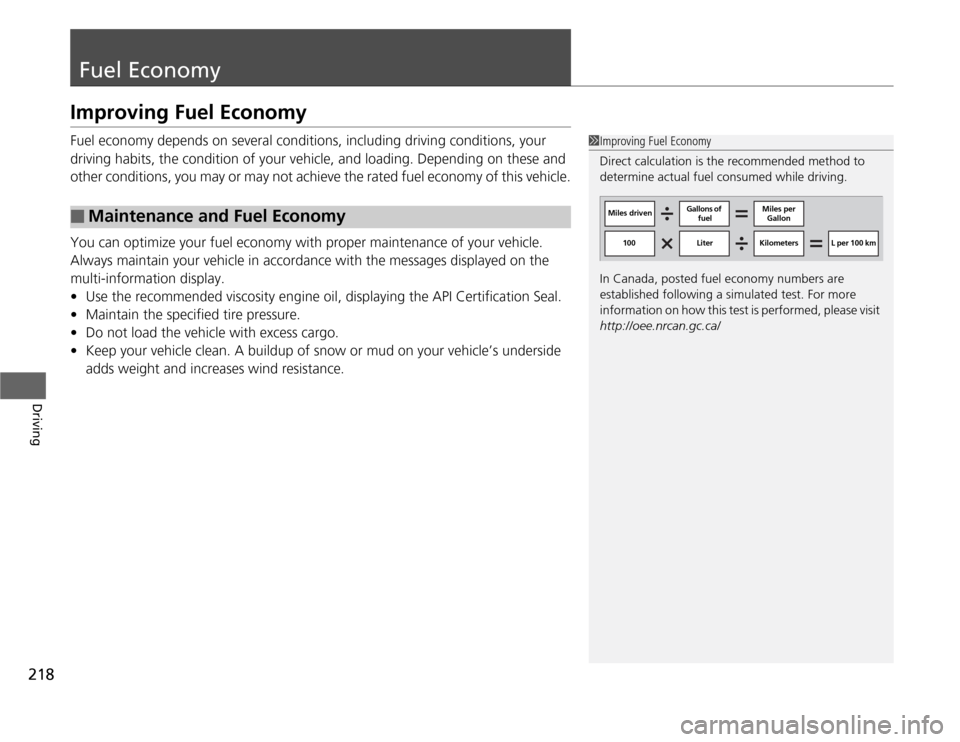
218Driving
Fuel EconomyImproving Fuel EconomyFuel economy depends on several conditions, including driving conditions, your
driving habits, the condition of your vehicle, and loading. Depending on these and
other conditions, you may or may not achieve the rated fuel economy of this vehicle.
You can optimize your fuel economy with proper maintenance of your vehicle.
Always maintain your vehicle in accordance with the messages displayed on the
multi-information display.
•Use the recommended viscosity engine oil, displaying the API Certification Seal.
•Maintain the specified tire pressure.
•Do not load the vehicle with excess cargo.
•Keep your vehicle clean. A buildup of snow or mud on your vehicle’s underside
adds weight and increases wind resistance.■
Maintenance and Fuel Economy
1Improving Fuel Economy
Direct calculation is the recommended method to
determine actual fuel consumed while driving.
In Canada, posted fuel economy numbers are
established following a simulated test. For more
information on how this test is performed, please visit
http://oee.nrcan.gc.ca/
Miles drivenGallons of
fuelMiles per
Gallon
100 Liter Kilometers L per 100 km
Page 223 of 324
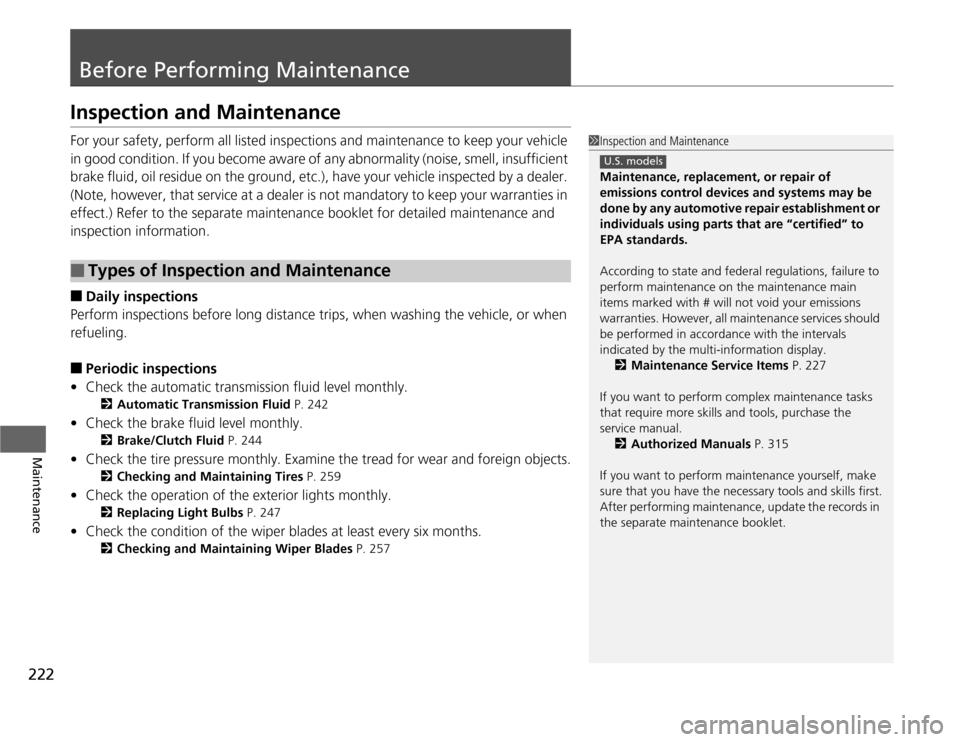
222Maintenance
Before Performing MaintenanceInspection and MaintenanceFor your safety, perform all listed inspections and maintenance to keep your vehicle
in good condition. If you become aware of any abnormality (noise, smell, insufficient
brake fluid, oil residue on the ground, etc.), have your vehicle inspected by a dealer.
(Note, however, that service at a dealer is not mandatory to keep your warranties in
effect.) Refer to the separate maintenance booklet for detailed maintenance and
inspection information.■
Daily inspections
Perform inspections before long distance trips, when washing the vehicle, or when
refueling.
■
Periodic inspections
•Check the automatic transmission fluid level monthly.
2Automatic Transmission Fluid P. 242
•Check the brake fluid level monthly.
2Brake/Clutch Fluid P. 244
•Check the tire pressure monthly. Examine the tread for wear and foreign objects.
2Checking and Maintaining Tires P. 259
•Check the operation of the exterior lights monthly.
2Replacing Light Bulbs P. 247
•Check the condition of the wiper blades at least every six months.
2Checking and Maintaining Wiper Blades P. 257
■
Types of Inspection and Maintenance
1Inspection and Maintenance
Maintenance, replacement, or repair of
emissions control devices and systems may be
done by any automotive repair establishment or
individuals using parts that are “certified” to
EPA standards.
According to state and federal regulations, failure to
perform maintenance on the maintenance main
items marked with # will not void your emissions
warranties. However, all maintenance services should
be performed in accordance with the intervals
indicated by the multi-information display.
2Maintenance Service Items P. 227
If you want to perform complex maintenance tasks
that require more skills and tools, purchase the
service manual.
2Authorized Manuals P. 315
If you want to perform maintenance yourself, make
sure that you have the necessary tools and skills first.
After performing maintenance, update the records in
the separate maintenance booklet.
U.S. models
Page 260 of 324
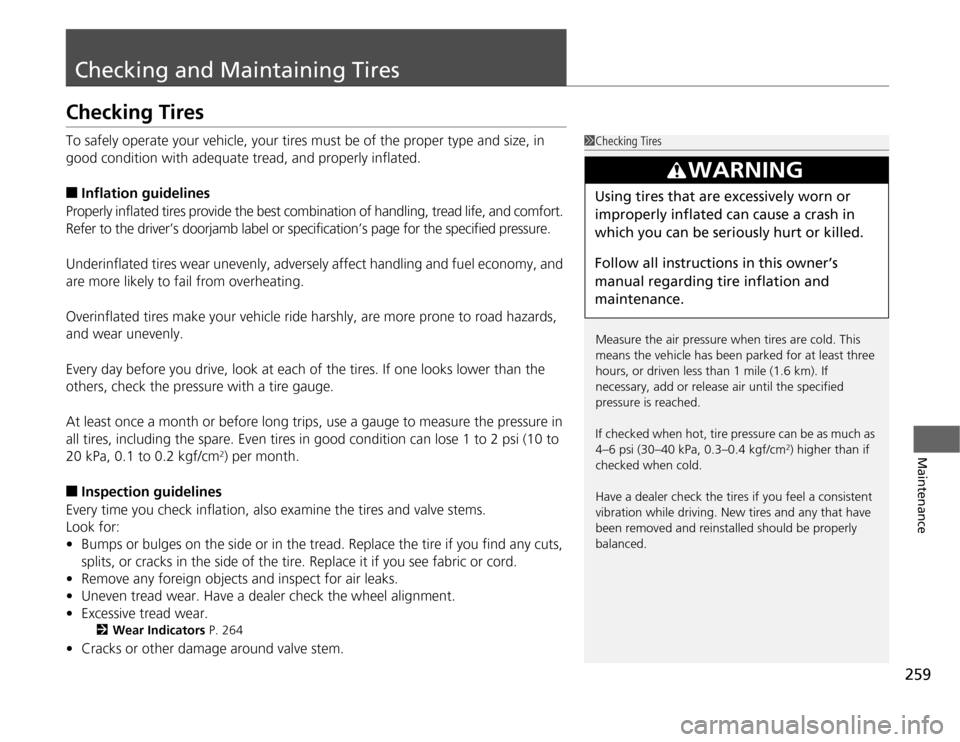
259
Maintenance
Checking and Maintaining TiresChecking TiresTo safely operate your vehicle, your tires must be of the proper type and size, in
good condition with adequate tread, and properly inflated.■
Inflation guidelines
Properly inflated tires provide the best combination of handling, tread life, and comfort.
Refer to the driver’s doorjamb label or specification’s page for the specified pressure.
Underinflated tires wear unevenly, adversely affect handling and fuel economy, and
are more likely to fail from overheating.
Overinflated tires make your vehicle ride harshly, are more prone to road hazards,
and wear unevenly.
Every day before you drive, look at each of the tires. If one looks lower than the
others, check the pressure with a tire gauge.
At least once a month or before long trips, use a gauge to measure the pressure in
all tires, including the spare. Even tires in good condition can lose 1 to 2 psi (10 to
20 kPa, 0.1 to 0.2 kgf/cm
2) per month.
■
Inspection guidelines
Every time you check inflation, also examine the tires and valve stems.
Look for:
•Bumps or bulges on the side or in the tread. Replace the tire if you find any cuts,
splits, or cracks in the side of the tire. Replace it if you see fabric or cord.
•Remove any foreign objects and inspect for air leaks.
•Uneven tread wear. Have a dealer check the wheel alignment.
•Excessive tread wear.
2Wear Indicators P. 264
•Cracks or other damage around valve stem.
1Checking Tires
Measure the air pressure when tires are cold. This
means the vehicle has been parked for at least three
hours, or driven less than 1 mile (1.6 km). If
necessary, add or release air until the specified
pressure is reached.
If checked when hot, tire pressure can be as much as
4–6 psi (30–40 kPa, 0.3–0.4 kgf/cm
2) higher than if
checked when cold.
Have a dealer check the tires if you feel a consistent
vibration while driving. New tires and any that have
been removed and reinstalled should be properly
balanced.
3
WARNING
Using tires that are excessively worn or
improperly inflated can cause a crash in
which you can be seriously hurt or killed.
Follow all instructions in this owner’s
manual regarding tire inflation and
maintenance.
Page 276 of 324

275
Handling the Unexpected
This chapter explains how to handle unexpected troubles.
Tools.................................................. 276
Types of Tools .................................. 276
If a Tire Goes Flat.............................. 277
Changing a Flat Tire ......................... 277
Engine Does Not Start
Checking the Engine ........................ 283
Jump Starting.................................... 284
Shift Lever Does Not Move.............. 287
Overheating...................................... 288
How to Handle Overheating ............. 288Indicator, Coming On/Blinking
If the Low Oil Pressure Indicator Comes
On.................................................. 290If the Charging System Indicator Comes
On ................................................. 290
If the Malfunction Indicator Lamp Comes
On or Blinks ................................... 291If the Brake System Indicator Comes On .. 292If the EPS Indicator Comes On.......... 292
If the Low Tire Pressure/TPMS Indicator
Comes On or Blinks........................ 293Fuses
Fuse Locations ................................. 294
Circuit Protected and Amps for Each
Fuse............................................ 296Inspecting and Changing Fuses ........ 298
Emergency Towing........................... 299
When You Cannot Unlock the Fuel Fill
Door................................................. 300
When You Cannot Open the Trunk.. 301
Page 318 of 324
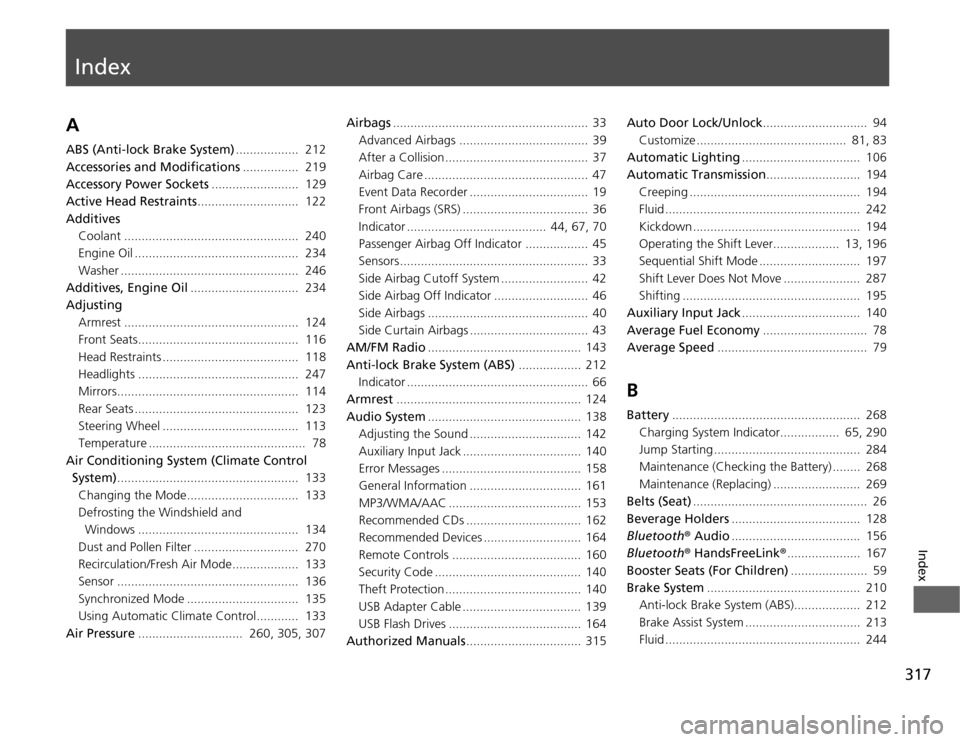
Index
317
Index
Index
AABS (Anti-lock Brake System).................. 212
Accessories and Modifications................ 219
Accessory Power Sockets......................... 129
Active Head Restraints............................. 122
Additives
Coolant .................................................. 240
Engine Oil ............................................... 234
Washer ................................................... 246
Additives, Engine Oil............................... 234
Adjusting
Armrest .................................................. 124
Front Seats.............................................. 116
Head Restraints ....................................... 118
Headlights .............................................. 247
Mirrors.................................................... 114
Rear Seats ............................................... 123
Steering Wheel ....................................... 113
Temperature ............................................. 78
Air Conditioning System (Climate Control
System).................................................... 133
Changing the Mode................................ 133
Defrosting the Windshield and
Windows .............................................. 134
Dust and Pollen Filter .............................. 270
Recirculation/Fresh Air Mode................... 133
Sensor .................................................... 136
Synchronized Mode ................................ 135
Using Automatic Climate Control............ 133
Air Pressure.............................. 260, 305, 307Airbags........................................................ 33
Advanced Airbags ..................................... 39
After a Collision ......................................... 37
Airbag Care ............................................... 47
Event Data Recorder .................................. 19
Front Airbags (SRS) .................................... 36
Indicator ........................................ 44, 67, 70
Passenger Airbag Off Indicator .................. 45
Sensors ...................................................... 33
Side Airbag Cutoff System ......................... 42
Side Airbag Off Indicator ........................... 46
Side Airbags .............................................. 40
Side Curtain Airbags .................................. 43
AM/FM Radio............................................ 143
Anti-lock Brake System (ABS).................. 212
Indicator .................................................... 66
Armrest..................................................... 124
Audio System............................................ 138
Adjusting the Sound ................................ 142
Auxiliary Input Jack .................................. 140
Error Messages ........................................ 158
General Information ................................ 161
MP3/WMA/AAC ...................................... 153
Recommended CDs ................................. 162
Recommended Devices ............................ 164
Remote Controls ..................................... 160
Security Code .......................................... 140
Theft Protection ....................................... 140
USB Adapter Cable .................................. 139
USB Flash Drives ...................................... 164
Authorized Manuals................................. 315Auto Door Lock/Unlock.............................. 94
Customize ........................................... 81, 83
Automatic Lighting.................................. 106
Automatic Transmission........................... 194
Creeping ................................................. 194
Fluid ........................................................ 242
Kickdown ................................................ 194
Operating the Shift Lever................... 13, 196
Sequential Shift Mode ............................. 197
Shift Lever Does Not Move ...................... 287
Shifting ................................................... 195
Auxiliary Input Jack.................................. 140
Average Fuel Economy.............................. 78
Average Speed........................................... 79
BBattery...................................................... 268
Charging System Indicator................. 65, 290
Jump Starting .......................................... 284
Maintenance (Checking the Battery) ........ 268
Maintenance (Replacing) ......................... 269
Belts (Seat).................................................. 26
Beverage Holders..................................... 128
Bluetooth® Audio..................................... 156
Bluetooth® HandsFreeLink®..................... 167
Booster Seats (For Children)...................... 59
Brake System............................................ 210
Anti-lock Brake System (ABS)................... 212
Brake Assist System ................................. 213
Fluid ........................................................ 244
Page 320 of 324

319
Index
Locking/Unlocking the Doors from the
Inside ...................................................... 93
Locking/Unlocking the Doors from the
Outside ................................................... 91
Lockout Prevention System ....................... 92
DOT Tire Quality Grading........................ 262
Driving...................................................... 181
Automatic Transmission .......................... 194
Braking ................................................... 210
Cruise Control ........................................ 201
Shifting Gear .................................. 195, 199
Starting the Engine ................................. 191
Driving Position Memory System............ 111
Dust and Pollen Filter.............................. 270
EElapsed Time.............................................. 79
Electric Power Steering System (EPS)
Indicator ........................................... 68, 292
Electronic Stability Control (ESC)............ 204
Emergency................................................ 299
Emergency Trunk Opener......................... 97
Emissions Testing (Readiness Codes)...... 311
Engine....................................................... 308
Coolant .................................................. 240
Jump Starting ......................................... 284
Oil .......................................................... 234
Starting................................................... 191
Switch Buzzer ......................................... 104Engine Coolant......................................... 240
Adding to the Radiator ............................ 241
Adding to the Reserve Tank ..................... 240
Overheating ............................................ 288
Temperature Gauge .................................. 75
Engine Oil................................................. 234
Adding .................................................... 237
Checking ................................................. 235
Displaying Oil Life .................................... 225
Low Oil Pressure Indicator .................. 64, 290
Recommended Engine Oil ........................ 234
EPS (Electric Power Steering
System).............................................. 68, 292
Exhaust Gas Hazard (Carbon Monoxide).. 60
Exterior Care (Cleaning)........................... 273
Exterior Mirrors........................................ 114
FFeatures..................................................... 137
Filters
Dust and Pollen ....................................... 270
Oil ........................................................... 238
Flat Tire..................................................... 277
Floor Mats................................................. 272
Fluids
Automatic Transmission ........................... 242
Brake/Clutch ............................................ 244
Engine Coolant ........................................ 240
Manual Transmission ............................... 243
Windshield Washer .................................. 246Fog Light Indicator..................................... 70
Folding Down the Rear Seats.................. 123
Foot Brake................................................ 211
Front Airbags (SRS)..................................... 36
Front Seats................................................ 116
Adjusting ................................................ 116
Fuel...................................................... 14, 215
Economy ................................................. 218
Gauge ....................................................... 75
Instant Fuel Economy ................................ 78
Low Fuel Indicator ..................................... 66
Range ....................................................... 78
Recommendation .................................... 215
Refueling................................................. 215
Fuel Economy........................................... 218
Fuel Fill Cap........................................ 14, 217
Message.................................................. 291
Fuel Fill Door...................................... 14, 216
Unable to Unlock .............................. 14, 216
Fuses.......................................................... 294
Inspecting and Changing......................... 298
Locations................................................. 294
GGasoline (Fuel)
Economy ................................................. 218
Gauge ....................................................... 75
Information ............................................. 215
Instant Fuel Economy ................................ 78
Low Fuel Indicator ..................................... 66